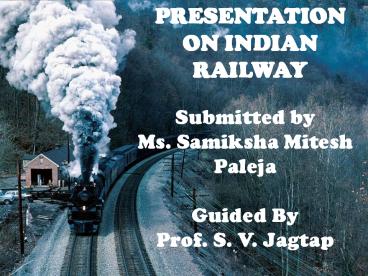PRESENTATION ON INDIAN RAILWAY - PowerPoint PPT Presentation
Title:
PRESENTATION ON INDIAN RAILWAY
Description:
Thi i my one of the favorite ppt i have ever made before and it has been also selected for the first prize in my department. – PowerPoint PPT presentation
Number of Views:28136
Title: PRESENTATION ON INDIAN RAILWAY
1
PRESENTATION ON INDIAN RAILWAY
Submitted by Ms. Samiksha Mitesh Paleja Guided
By Prof. S. V. Jagtap
2
ABOUT INDIAN RAILWAY
Indian Railways is an Indian state-owned
enterprise, owned and operated by the government
of India through the Ministry of Railways. It is
one of the world's largest railway networks
comprising 115,000 km (71,000 mi) of track over a
route of 65,000 km (40,000 mi) and 7,500 stations.
3
In India first railway was built between Mumbai
and Thane in 1852 and the first passenger train
ran between the two stations, covering a distance
of 34 km, on April 16, 1853.
4
ZONES OF INDIAN RAILWAY
- EASTERN RAILWAY
- SOUTH CENTRAL RAIWAY
- NORTHEN RAILWAY
- NORTH EASTERN RAILWAY
- SOUTHERN RAILWAY
- CENTRAL RAILWAY
- WESTERN RAILWAY
- NORTH EAST FRONTIER RAILWAY
- SOUTH CENTRAL RAILWAY
5
(No Transcript)
6
SOME OF THE HEADQUARTERS IN INDIA
INDIAN RAILWAYS HEADQUARTERS DELHI
CENTRAL RAILWAY HEADQUARTERS SHIVAJI CHATRAPATI
TERMINUS,MUMBAI
WESTERN RAILWAY HEADQUARTERS, MUMBAI
SOUTHERN RAILWAY HEADQUARTERS, CHENNAI
7
RAIL GAUGE The clear
horizontal distance between the inner faces of
the two rails forming a track is known as gauge.
8
- TYPES OF GAUGES PREVALENT IN INDIA
- Broad gauge (1676 mm)
- When the clear
horizontal distance between the inner faces of
two parallel rails forming a track is 1676 mm ,
the gauge is called as broad gauge. - Meter gauge (1000 mm)
- When the clear
horizontal distance between the inner faces of
two parallel rails forming a track is 1000 mm ,
the gauge is called as meter gauge. - Narrow gauge (762 mm or 610 mm)
- When the clear
horizontal distance between the inner faces of
two parallel rails forming a track is 1000 mm ,
the gauge is called as narrow gauge. -
9
RAILS
The rolled steel sections
laid end to end in two parallel lines over
sleepers to form a railway track are known as
rails.
10
1. Double headed rail The
rail sections having their head and foot of same
dimensions , are known as double headed rails.
2. Bull headed rail
The rail sections having their head of
more dimensions than that of their foot are
known as bull headed rail.3. Flat footed rail
The rail sections having their
foot rolled or flat, are known as flat footed
rail.
Types of Rails
11
(No Transcript)
12
Sleepers The members
laid transversely under the rail for supporting
and fixing them at the gauge distance apart are
known as sleepers.
Sleepers
13
Ballast The material placed in between
the sleeper and the top of the formation is known
as the ballast.
Ballast
14
Coning of wheels
"Coning of wheels" is what allows a train to take
a turn without slipping off its tracks.
15
Tilting of rails The rails are
placed with an inward slope of 1 in 20 on the
railway track and this art of placing of rails is
called as tilting of rails.
A Japanese kiHa 283 series tilting DMU which can
tilt upto 8 ( 6 in normal operation)
16
Rails Fixtures and Fastening
Fish plate A fish plate is a metal or
wooden plate that is bolted to the sides at the
ends of two rails or beams, to join them.
Spikes A rail spike (also known as a
cut spike or crampon) is a large nail with an
offset head that is used to secure rails and base
plates to railroad ties in the track.
Bearing plate These are the plates which
are provided in between the flat footed rails and
wooden sleepers
Bolts Bolts are used for connecting
fish plates to the rails at rail joint, bearing
plates and chairs to wooden sleepers etc.
17
Thank you































